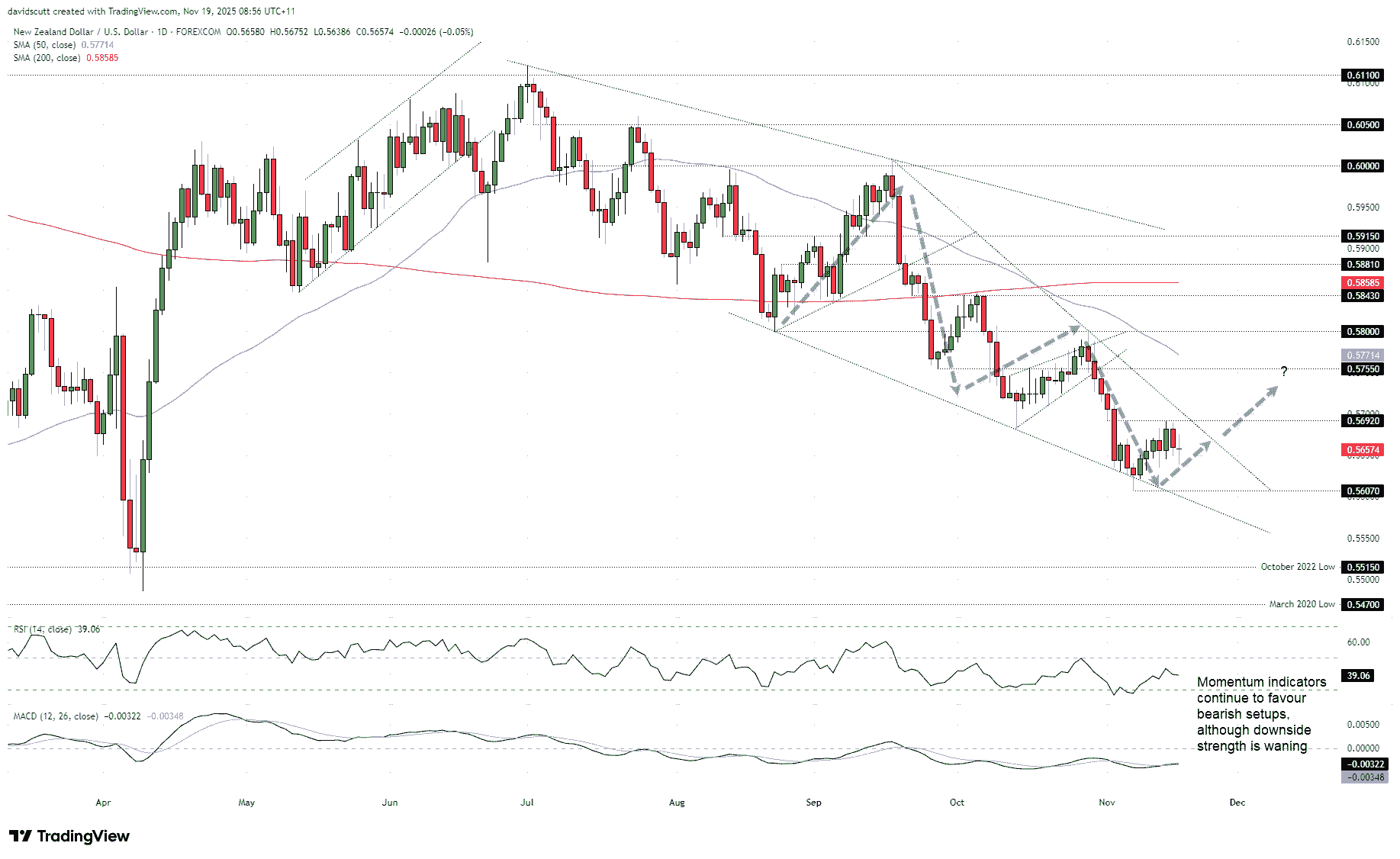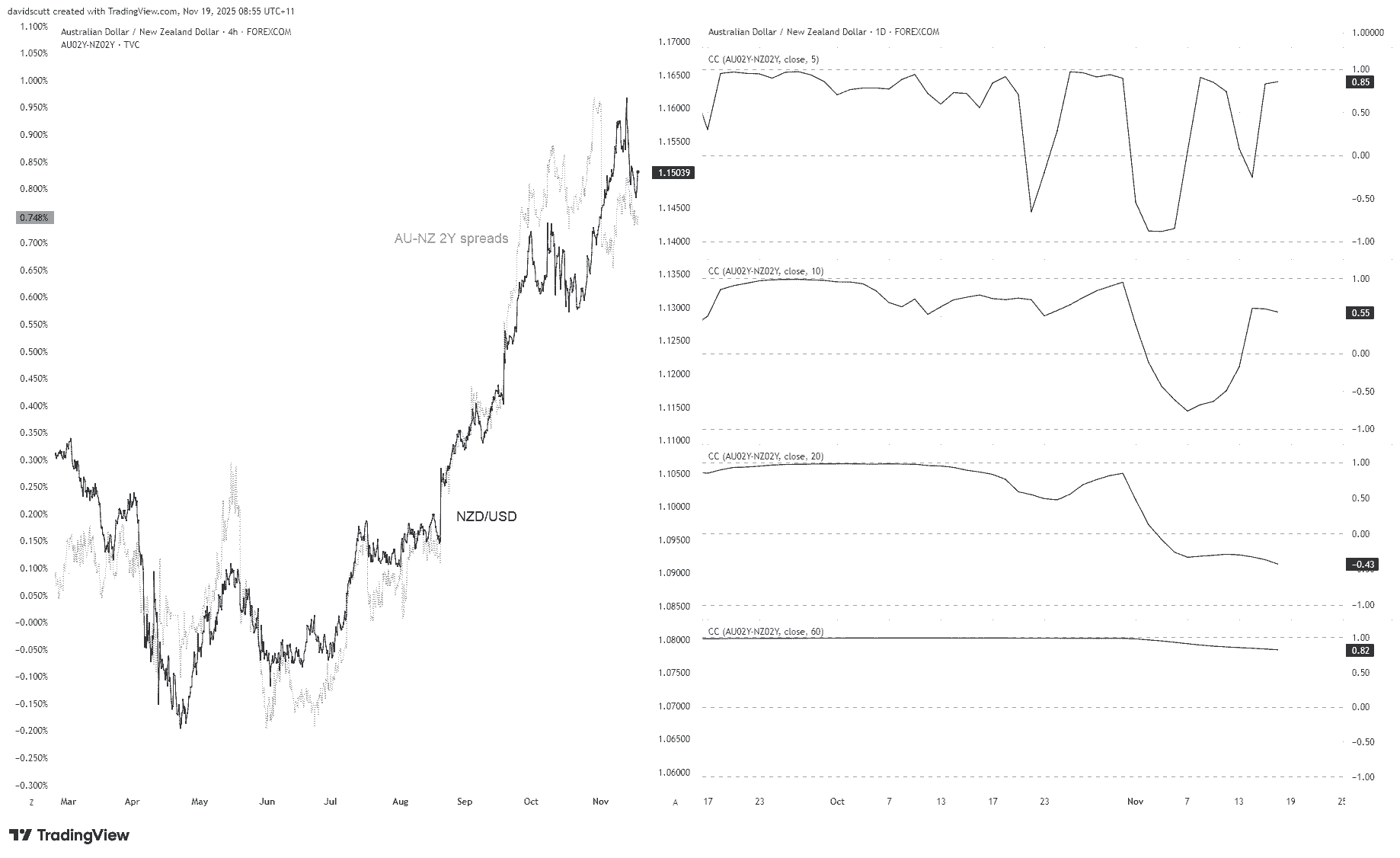Michael Burry warns of ‘suspicious revenue recognition’ after Nvidia earnings
NZD/USD has stopped responding to the indicators it normally tracks, leaving price action to do more of the heavy lifting in judging directional risks.
- NZD/USD no longer trading like a high-beta risk asset.
- Traditional drivers, including China proxies, offer little guidance.
- Price action and technicals are now central to assessing directional risks.
- Relative central bank outlooks key long-term driver for AUD/NZD.
Summary
The New Zealand dollar’s characteristics have shifted over the past fortnight, no longer trading like a risk asset as was the case entering November. Unusually, it’s not demonstrating any strong relationship with cyclical assets—including those closely linked to China—nor rate differentials between New Zealand and the United States.
With its traditional drivers absent, price action in NZD/USD may take precedence when evaluating directional risks. However, for AUD/NZD, central bank expectations remain the dominant driver, putting increased emphasis on key economic data from both Australia and New Zealand when it comes to trade entry and exit points.
A China Proxy No Longer?
The graphic below tracks the correlation coefficients between NZD/USD and a variety of market indicators. In the middle pane we have scores over the past 10 days, with those over the past 60 days detailed in the right-hand pane. From top to bottom, it shows pricing for Fed rate cuts out to the end of 2026, as measured by the futures curve, followed by 2-year and 10-year yield spreads between New Zealand and the United States.
The final four are USD/CNH, BTC/USD, copper and VIX futures.
Source: TradingView
In simple terms, correlation coefficients tell you whether two things tend to move together, move in opposite directions, or don’t have much of a relationship at all. The values range from -1 to +1. A reading near +1 signals they usually rise or fall together. A reading near -1 means they tend to move in opposite directions. A reading near zero suggests little or no consistent relationship.
What’s noticeable over the past fortnight is that NZD/USD has not shown a strong relationship—or inverse relationship—with indicators it has in the past, such as yield differentials and the offshore-traded yuan. And while NZD/USD demonstrated a strong link with BTC/USD, VIX, and copper futures entering November, indicating it was behaving like a risk asset, those correlations have broken down over the past week. The Kiwi has been doing its own thing based on these indicators.
Over a longer period, NZD/USD has shown the strongest relationship with benchmark 10-year yield differentials between New Zealand and the United States, but that too has been weakening recently. It’s not at extreme levels yet, but at 0.6 and -0.69, respectively with bitcoin and VIX futures, the Kiwi’s relationship with risk proxies has been increasing.
Unusually, with China-linked markets like copper futures and USD/CNH, the relationship has either been non-existent or the opposite of what you would historically expect.
With no dominant driver over either the short or longer term, it hints that price action in NZD/USD may be as useful as anything when assessing directional risks.
NZD/USD: Bearish Now, Bullish Later

Source: TradingView
Looking at the daily chart, NZD/USD remains a clear sell-on-rallies play, sitting in a downtrend since September characterised by a series of lower highs and lower lows. With a negative slope, the 50-day moving average reinforces the overall bearish bias.
Zooming in, levels to watch for near-term setups include the November low of .5607 on the downside and .5692 resistance on the topside. .5650 appears to be acting as a pivot point within that range, with dips beneath it bought frequently over the past week. Beyond the existing .5607-.5692 range, .5515 has sparked large bounces in the recent past, making it relevant should we see a downside break. Should we see a topside break, .5755, 50DMA, .5800, .5843 and 200DMA are the levels to watch.
The focus on higher levels is deliberate given the falling wedge pattern NZD/USD finds itself coiling in, hinting at a potential bullish move. There’s no risk of that in the ultra-near term, but keep a lookout should we see a breach of the September downtrend.
Fitting with the price action, the message from RSI (14) and MACD continues to be bearish, favouring short setups in the near term over longs. However, with downside strength now waning, it provides a warning to bears not to get too greedy around these historically depressed levels.
AUD/NZD: Central Bank Outlooks Key

Source: TradingView
When it comes to AUD/NZD over both the short and longer term, relative central bank policy settings between the RBA and RBNZ have been a dominant driver, as seen in the correlation coefficient scores with two-year yield differentials between the two nations over the past five, 10, 20 and 60 days below. While the strength of the relationship has weakened over the past fortnight and broken down entirely over the past month, it has been strong over the past week. As shown in the left-hand pane, there has been a solid link between rate differentials and AUD/NZD for much of the year, with the rolling 60-day correlation coefficient sitting at 0.82 having been well above 90 up until November. That suggests any data or event that can influence the RBA or RBNZ monetary policy outlook remains highly relevant to anyone trading the pair, including today’s Australian Q3 wages data.
AUD/NZD Bullish Trend May Have Legs

Source: TradingView
With the RBNZ turning dovish at the same time RBA pricing has tilted hawkish, it comes as little surprise that AUD/NZD sits in a strong uptrend, having hit more-than-decade highs just last week. Even though upside momentum has weakened a touch recently, the message from RSI (14) and MACD continues to favour buying dips over selling rips.
Zooming in, the price bounced nicely off the August uptrend on Tuesday. That level, along with the October 8 high at 1.1445 found just below, are the ones to keep an eye on the downside for guidance on near-term directional risks. Above these levels, some resistance has been noted above 1.1500 up to 1.1513, with a break above that zone opening the door for a potential run back towards the November high above 1.1630. 1.1755 is the next topside level to watch should we see an extension of the bullish trend.
On the downside, a break and close beneath the August uptrend and 1.1445 would warn of a potential trend change, putting the 50-day moving average and 1.1280 on the radar should we see some form of retracement. While the bearish pin from last week warns of downside risks, until proven otherwise, the subsequent pullback looks corrective rather than the start of a new trend.
